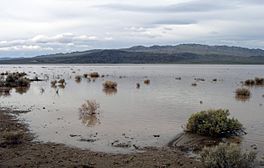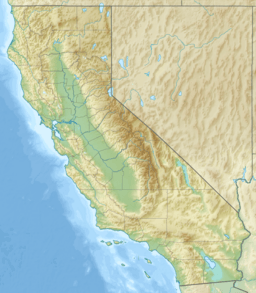Silver Lake (Mojave) facts for kids
Quick facts for kids Silver Lake |
|
|---|---|

Silver Lake after a flood in March 2005.
|
|
| Location | Mojave Desert San Bernardino County, California |
| Coordinates | 35°20′17″N 116°06′32″W / 35.3380°N 116.1089°W |
| Type | Endorheic basin |
| Primary inflows | Mojave River |
| Primary outflows | Terminal (evaporation) |
| Basin countries | United States |
| Max. length | 12 km (7.5 mi) |
| Max. width | 5 km (3.1 mi) |
| Shore length1 | 30 km (19 mi) |
| Surface elevation | 280 m (920 ft) |
| Settlements | Baker, California |
| 1 Shore length is not a well-defined measure. | |
Silver Lake is a dry lake bed located in the Mojave Desert in San Bernardino County, California. A dry lake bed is an area that used to be a lake but is now usually dry. You can find it along Interstate 15, about 100 kilometers (62 miles) northeast of Barstow.
The History of Silver Lake
Long, long ago, Silver Lake and its neighbor, Soda Lake, were part of a much bigger lake called Lake Mojave. Lake Mojave was a huge lake that always had water. It existed during a time called the Holocene epoch, which started about 11,700 years ago and continues today. Over time, as the climate changed, Lake Mojave dried up, leaving behind these smaller, often dry, lake beds.
Where is Silver Lake Located?
The Mojave River usually ends at Soda Lake. However, during very wet periods, the river has flowed all the way into Silver Lake. This happened most recently in the very rainy winter of 2004–2005.
There is also a channel between Soda Lake and Silver Lake. This channel has been changed by humans to help manage water flow. While Silver Lake sometimes has water, it is usually dry for most of the year.
Why Silver Lake Has No Salt Crusts
Unlike Soda Lake, Silver Lake does not have thick layers of salt on its surface. This is because the groundwater (water found underground) is deeper at Silver Lake.
Salt crusts form when salty groundwater rises to the surface through a process called capillary action. This is like how water moves up a thin straw. When the water reaches the surface, it evaporates (turns into vapor), leaving the salt behind. Because the groundwater is deeper at Silver Lake, this process happens less often, so salt crusts do not form.



